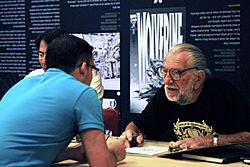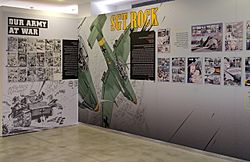Joe Kubert facts for kids
Quick facts for kids Joe Kubert |
|
|---|---|

Kubert at the Big Apple Comic Con in Manhattan, October 17, 2009.
|
|
| Born | September 18, 1926 Jezierzany, Poland (now Ozeryany, Ternopil Region, Ukraine) |
| Died | August 12, 2012 (aged 85) Morristown, New Jersey |
| Nationality | American |
| Area(s) | Writer, Artist |
|
Notable works
|
Fax from Sarajevo Sgt. Rock Hawkman Tarzan |
| Awards | Alley Award (1962, 1963, 1969) National Cartoonists Society Awards (1974, 1980) Eisner Award (1977) Harvey Award (1997) Inkwell Awards Joe Sinnott Hall of Fame (2015). |
| Spouse(s) | Muriel Fogelson (1951–2008; five children) |
| www.kubertschool.edu | |
Joseph Kubert (September 18, 1926 – August 12, 2012) was a famous American comic book artist and teacher. He was born in Poland and moved to the United States when he was a baby. Joe Kubert is best known for drawing popular characters like Sgt. Rock and Hawkman for DC Comics. He also created his own characters, such as Tor.
Kubert was a very important artist in the comic book world. He was honored in the Harvey Awards' Jack Kirby Hall of Fame in 1997. He was also added to the Will Eisner Comic Book Hall of Fame in 1998. These halls of fame celebrate the best creators in comics.
Contents
Early Life and First Drawings
Joe Kubert was born on September 18, 1926, in Jezierzany, Poland. His family was Jewish. When he was two months old, he moved to Brooklyn, New York City, with his parents and older sister.
Joe grew up in the East New York neighborhood. His father was a butcher. Joe started drawing at a very young age. His parents always encouraged him to draw.
Kubert once said he got his first paying job as a cartoonist when he was about 11 or 12 years old. He earned five dollars a page, which was a lot of money in 1938. He would sometimes skip school to visit comic book publishers.
Joe went to the High School of Music and Art in Manhattan. He learned a lot about drawing there. He also worked at the Chesler studio, which created comic books for publishers. This helped him improve his skills.
Starting His Career
Joe Kubert's first professional comic book job was in March 1942. He drew a six-page story called "Black-Out" for Catman Comics. He continued to draw for this series. Soon, he was also drawing for other companies like Fox Comics.
He also started coloring comic books. He colored reprints of The Spirit, a popular comic feature by Will Eisner. This work helped him learn more about the comic book industry.
Working with DC Comics
Kubert began working for DC Comics in 1943. This is where he would create some of his most famous art. His first DC work was a 50-page story for the superhero team "Seven Soldiers of Victory".
Throughout the 1940s, Kubert drew for many comic companies. But he mostly worked for DC Comics. His long connection with the Hawkman character began in 1944. He drew many Hawkman stories.
In the 1950s, Kubert became an editor at St. John Publications. There, he helped create the first 3-D comic books. The first one, Three Dimension Comics #1, featured Mighty Mouse. It sold an amazing 1.2 million copies!
Joe Kubert also created the character Tor with writer Norman Maurer. Tor is a prehistoric human hero. He first appeared in 1953. Tor later got his own comic book series.
Famous Works and The Kubert School
In 1955, Joe Kubert started working for DC Comics full-time again. He joined writer Robert Kanigher and artist Carmine Infantino to bring back the Flash character. This new Flash was very successful. It helped start the "Silver Age of Comic Books", when superheroes became popular again.
Kubert then worked on characters like the Viking Prince. He also drew for war comics like G.I. Combat. His work on Sgt. Rock and G.I. Combat became very well-known. He and writer Robert Kanigher created Enemy Ace in 1965.
From 1967 to 1976, Kubert was a director at DC Comics. He helped create new comic book titles. These included comics based on Edgar Rice Burroughs' characters like Tarzan and Korak. He continued to draw for some of these books, especially Tarzan.
The Kubert School
Joe Kubert and his wife, Muriel, started The Joe Kubert School of Cartoon and Graphic Art in September 1976. It was in Dover, New Jersey. The school teaches students how to draw and create comics. Many of Kubert's students later became famous comic book artists themselves. These include his sons, Andy Kubert and Adam Kubert.
Later Career and Legacy
Kubert continued to draw for many important DC Comics issues. He drew a Hawkman story for Detective Comics #500 in 1981. He also contributed to Justice League of America #200 and Batman #400.
In 1996, Kubert wrote and drew a powerful graphic novel called Fax from Sarajevo. This non-fiction book told the true story of a comics agent named Ervin Rustemagić. Ervin sent faxes to Kubert from Sarajevo during a war. The book showed what life was like during that difficult time.
Joe Kubert also drew for Stan Lee's Just Imagine... series in 2001. He created two graphic novels, Yossel: April 19, 1943 (2003) and Jew Gangster (2005). In 2003, he returned to Sgt. Rock, drawing Sgt. Rock: Between Hell and a Hard Place.
In 2008, Kubert brought back his character Tor with a new series called Tor: A Prehistoric Odyssey. He also drew a new Sgt. Rock story for Wednesday Comics in 2009. His son, Adam, wrote the story.
Joe Kubert continued to work on comics until his death. He even inked his son Andy's pencils for the Before Watchmen: Nite Owl series. The last two issues of this series were released after he passed away.
Personal Life
Joe Kubert married Muriel Fogelson on July 8, 1951. They had five children together: David, Danny, Lisa, Adam, and Andy. Adam and Andy both became successful comic book artists, just like their father.
Kubert's granddaughter, Katie Kubert, also works in comics as an editor. His grandson, Orion Zangara, is also a comic book artist.
Joe Kubert passed away on August 12, 2012, at the age of 85. His wife, Muriel, had passed away in 2008.
Awards and Honors
Joe Kubert received many awards for his amazing work:
- The Alley Award for Best Single Comic Book Cover in 1962.
- A special Alley Award in 1969 for his exciting storytelling in comics.
- The National Cartoonists Society Awards in 1974 and 1980.
- The Inkpot Award in 1977.
- The Eisner Award for "Best Graphic Album: New" for Fax from Sarajevo in 1997.
- The Harvey Award for "Best Graphic Album of Original Work" for Fax from Sarajevo in 1997.
Kubert was inducted into the Jack Kirby Hall of Fame in 1997. He was also inducted into the Will Eisner Comic Book Hall of Fame in 1998. In 2009, he received the Milton Caniff Lifetime Achievement Award. This award honors artists who have had a long and successful career.
In 2015, Kubert was given the Inkwell Awards Joe Sinnott Hall of Fame Award. His grandson, Orion Zangara, accepted the award for him.
See also
 In Spanish: Joe Kubert para niños
In Spanish: Joe Kubert para niños



